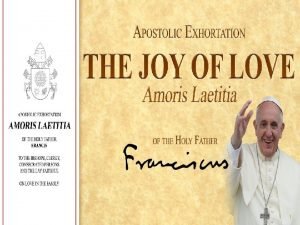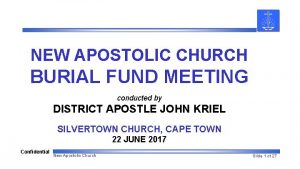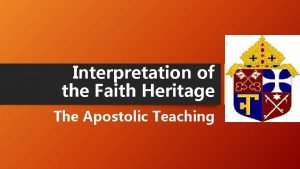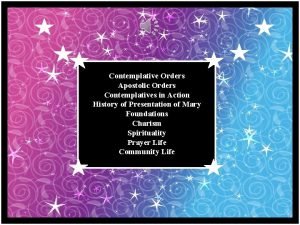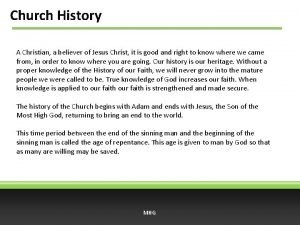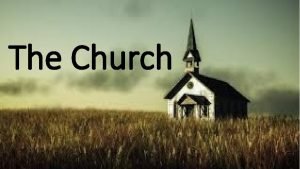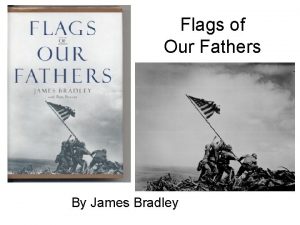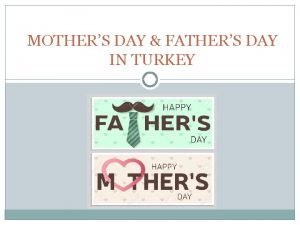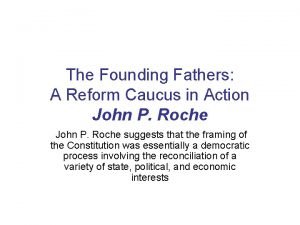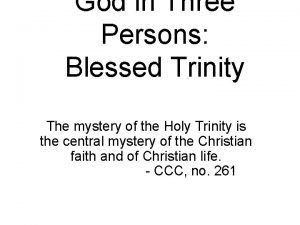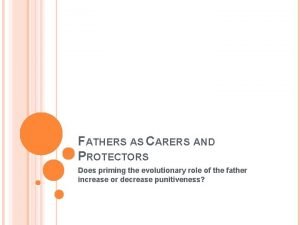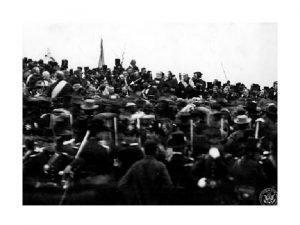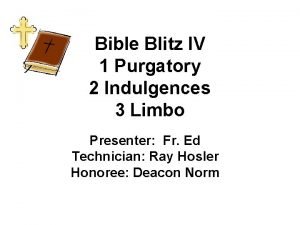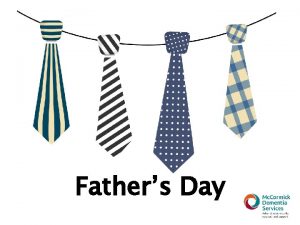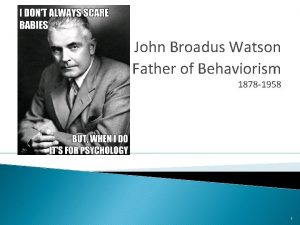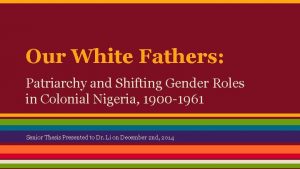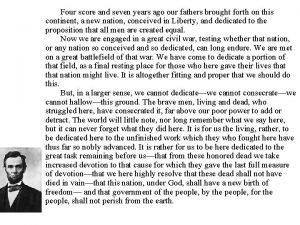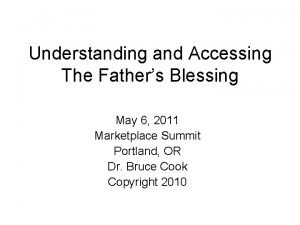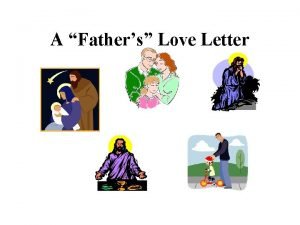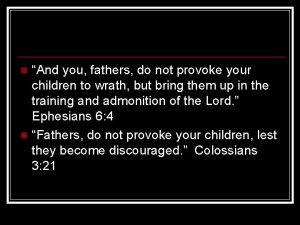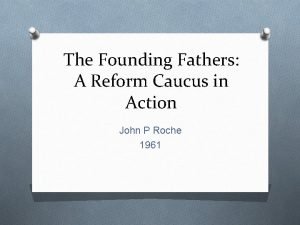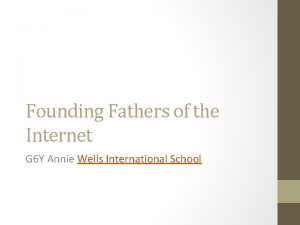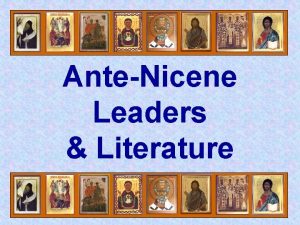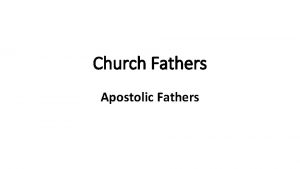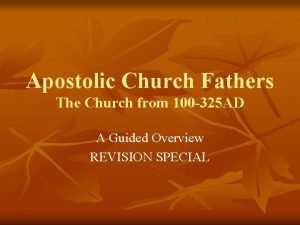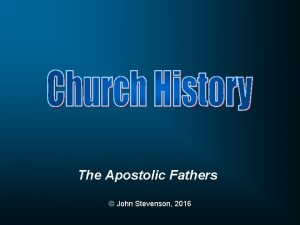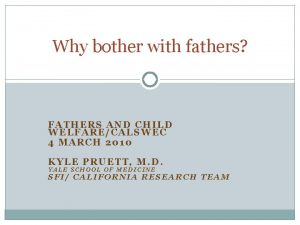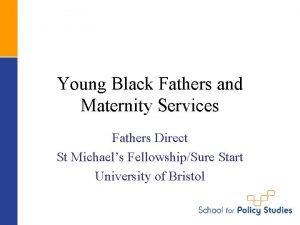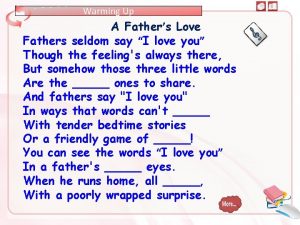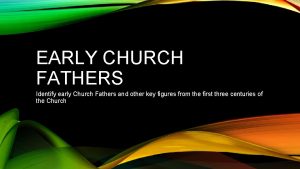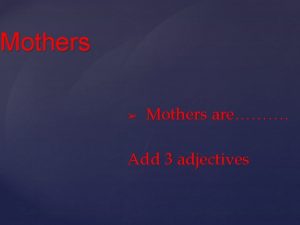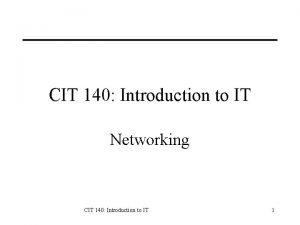The Apostolic Fathers AD 95 to 140 So

























- Slides: 25


The Apostolic Fathers (AD 95 to 140) So far we have studied: • 1 Clement – Was a letter written from the church at Rome to the Church at Corinth (the name “Clement” is never mentioned in the actual letter) to rebuke them for having cast out their former elders without just cause. – Contains prolific scripture citations as well as sound ecclesiology and theology • The Didache – Its title comes from the Greek word for “teaching”. It originated from Syria, but we do not know who wrote it. – Is the oldest surviving handbook of church discipline, dating from about AD 100. – Is similar to the book of James – it is intended as a brief summary for someone newly converted out of paganism. – Widely quotes from scripture and contains sound theology, ecclesiology, and eschatology

The Apostolic Fathers (AD 95 to 140) • The Letter to Diognetus – Written between AD 100 and 150 – No one knows who wrote this letter, or who Diognetus was. – The letter set out to show the falsehood of Paganism and Judaism, and the superior teaching of Christianity. • The Letter of Barnabas – Thought by historians to have been written in Alexandria in around AD 120 – Not to be confused with the Gospel of Barnabas, a very late (13 th century) forgery full of wild-eyed anachronisms. – Though it bears his name, the Letter of Barnabas was most assuredly not written by Paul’s companion, Barnabas. – Contains mostly good theology, but has shows a strong anti. Semitism and grossly misreads the OT.

The Apostolic Fathers (AD 95 to 140) • Ignatius of Antioch – Ignatius (AD 35 – 107) was the bishop of the church in Antioch at the beginning of the 2 nd century. – Arrested for being a Christian, he was taken to Rome by a military escort, where he was executed under the emperor Trajan. – As Ignatius journeyed to Rome, he wrote seven letters – When reading material claimed to be from Ignatius, we need to beware of the pseudo-Ignatian Epistles, which historians now recognize were not written by Ignatius.

Review of Polycarp • Who was Polycarp and what is he most known for? – Polycarp (AD 69 -156) was bishop of the church of Smyrna in Asia Minor and one of the most famous martyrs of the 2 nd century. – We know more about the martyrdom of Polycarp than we know about the life of Polycarp. • What writings do we have of Polycarp? – We have one letter written by him to the Philippians and it’s fairly short. • Why do we know so much about his martyrdom? – Because of a letter from the church of Smyrna (where Polycarp was bishop) to the church in Philomelium that gives a detailed account of the events of his death.

Review of Polycarp • What did the Romans typically try to get the Christians to do before torturing them to death for their Christian faith? – Curse Christ and offer some kind of worship to the emperor (by acknowledging the emperor as Lord and/or offering some kind of sacrifice or incense to him). • What would the Romans do to a Christian who was willing to recant his faith and worship the emperor? – They would let him go and do him no further harm. • What part of the account of Polycarp’s martyrdom had the biggest impact on you and why?

Papias https: //thebodythebride. wordpress. com/2016/01/18/what-did-papias-of-hierapolis-teach/

*Papias • Papias (AD 110 -30) was bishop of the church in Hierapolis in Phrygia, Asia Minor. (Needham, Nick. 2, 000 Years of Christ's Power ) • Very little is known of Papias apart from what can be inferred from his own writings, most of which has been lost apart from brief excerpts in the works of Irenaeus (AD 180) and Eusebius (AD 320). (Wikipedia article on Papias) • Irenaeus tells us that Papias knew the Apostle John. • Eusebius tells us that Papias: – Held a premillennial view of eschatology – Claimed that Mark’s Gospel was based on Peter’s words – Claimed that Matthew’s Gospel was originally written in Aramaic *Except where otherwise noted, based on notes taken from James White’s 2016 Church History Series; Lesson 13 – Papias and Early Church Structure

Papias

Papias

*Papias • Papias set out to preserve as much as he could of the deeds and sayings of Christ which had not been recorded in the Gospels, collecting accounts of these deeds and sayings from Jewish Christians who had been dispersed from Jerusalem, who in turn claimed they had received them from the apostles. • Many of these alleged sayings of Christ are very strange; the Church as a whole did not recognize them as genuine, although some Christians accepted some of them. * Needham, Nick. 2, 000 Years of Christ's Power Vol. 1: The Age of the Early Church Fathers

Shepherd of Hermas https: //thebodythebride. wordpress. com/2016/01/18/what-did-papias-of-hierapolis-teach/

Shepherd of Hermas • Written in Rome around the middle of the second century, this was said to be the work of a Christian prophet called Hermas and was very popular for centuries. * • In this book, Hermas describes a series of revelations that he claims to have received from two heavenly figures: an old woman and an angel dressed as a shepherd. • The book contains five visions, twelve commandments, and ten parables. • The visions and parables are somewhat obscure, but the commandments are straightforward: One should do good deeds, be truthful, pay alms, and remain pure. • A major concern that is raised in the book is whether Christians can be forgiven for committing serious sins after baptism. Hermes has heard from “certain teachers” that there can be no forgiveness of serious sins after one’s baptism. The angel tells him that serious post-baptismal sin can be forgiven - but only once. *https: //carm. org/should-the-shepherd-of-hermas-be-considered-scripture

Worship in the Early Church https: //www. christianitytoday. com/history/issues/issue-37/worship-in-early-church-did-you-know. html

Worship in the Early Church • What was a Christian service of worship like in the 2 nd century? We are fortunate in having a good description of a normal Christian gathering for worship in the writings of the 2 nd century theologian, Justin Martyr, who we will study in more detail later. • In his First Apology, Justin says: • On the day called Sunday there is a meeting of all believers who live in the town or the country, and the memoirs of the apostles, or the writings of the prophets, are read for as long as time will permit. When the reader has finished, the president in a sermon urges and invites the people to base their lives on these noble things. * Needham, Nick. 2, 000 Years of Christ's Power Vol. 1: The Age of the Early Church Fathers

Worship in the Early Church (Justin Martyr continued…) • Then we all stand up and offer prayers. When our prayer is concluded, bread and wine and water are brought; and the president offers up prayers and thanksgivings to the best of his ability, and the people assent with Amen. Then follows the distribution of the things over which thanks have been offered, and the partaking of them by all. • We hold our common assembly on Sunday because it is the first day, on which God put to flight darkness and chaos and made the world; and on the same day, Jesus Christ our Savior rose from the dead. * Needham, Nick. 2, 000 Years of Christ's Power Vol. 1: The Age of the Early Church Fathers

*Worship in the Early Church • The “president” of the assembly, who expounded the Scriptures and oversaw holy communion, was the senior presiding elder – that is, as Church organization developed in the 2 nd century, the bishop. • In another place, Justin gives a more detailed account of the Lord’s supper or Eucharist: • Then bread and a cup of wine mixed with water are brought to the president of the brothers. He takes them and offers up praise and glory to the Father of the universe, through the name of the Son and of the Holy Spirit. He gives thanks at considerable length for our being counted worthy to receive these things from His hands. When he has finished the prayers and thanksgivings, all the people present express their joyful agreement by saying Amen. (“Amen” means “Let it be so” in Hebrew). * Needham, Nick. 2, 000 Years of Christ's Power Vol. 1: The Age of the Early Church Fathers

Worship in the Early Church (Justin Martyr continued…) • Then those whom we call deacons give to each of those present the bread and the wine mixed with water over which the thanksgiving was pronounced, and carry away a portion to those who are absent. • We call this food “Eucharist”, which no-one is allowed to share unless he believes that the things we teach are true, and has been washed with the washing that is for the forgiveness of sins and a second birth, and is living as Christ has commanded. For we do not receive them as common bread and common drink. But as Jesus Christ our Savior became flesh by the word of God, and clothed Himself in our flesh and blood to save us, so also we have been taught that the food which is blessed by the word of prayer handed down from Christ, by which our blood and flesh are nourished as the food becomes part of ourselves, is the flesh and blood of the same Jesus who became flesh. * Needham, Nick. 2, 000 Years of Christ's Power Vol. 1: The Age of the Early Church Fathers

Worship in the Early Church (Justin Martyr continued…) • For the apostles, in the memoirs composed by themselves called “Gospels”, have delivered to us what was commanded to them: that Jesus took bread, and when He had given thanks said, “Do this in remembrance of Me, this is My body”; and in a similar way, after taking the cup and giving thanks, He said, “This is My blood, ” and gave it only to them. ” * Needham, Nick. 2, 000 Years of Christ's Power Vol. 1: The Age of the Early Church Fathers

Worship in the Early Church • From Justin’s account, we learn that the main ingredients of Christian worship in the 2 nd century were: – The Reading and Expounding of Scripture, – Prayer – The celebration of the Lord’s supper. • Indeed, compared with many churches today, the Lord’s supper held a remarkably high place in early Christian worship. The local church celebrated it every Sunday and it formed a large part of the service. * Needham, Nick. 2, 000 Years of Christ's Power Vol. 1: The Age of the Early Church Fathers

Worship in the Early Church • Singing, which for many modern Christians is such a central part of worship, was not so important in the early Church; in fact, Justin does not mention it here at all. • However, he does mention it elsewhere, and we know from other accounts that singing and chanting were a widespread practice in the worship of the early Christians. • In the 2 nd century, the most common form of singing and chanting was “responsive”. This means that one person (a Scripture reader or a clergyman) would sing or chant a passage, usually from a psalm, and the congregation would then make a response – either a single word, such as “Alleluia”, or a chorus. • There was also solo singing and full congregational singing, although the latter did not really become popular until the 4 th century. * Needham, Nick. 2, 000 Years of Christ's Power Vol. 1: The Age of the Early Church Fathers

Worship in the Early Church • What the early Christians chanted and sang were the Psalms of the Old Testament, and some of the poetic parts of the New Testament (e. g. the Virgin Mary’s praise of God in Luke 1: 46 -55). • It was probably not until the 4 th century that the singing of hymns written by ordinary Christians began to become common. • However, one of the greatest patristic hymns, the Gloria in excelsis (“Glory in the highest”, based on Luke 2: 14), dates from the 2 nd or 3 rd century. • No musical instruments accompanied the chanting and singing; Christians did not use instruments in their worship in the 2 nd century, or indeed for many centuries afterwards. • The early Church looked on musical instruments as being part of Jewish or Pagan worship, but not part of the apostolic tradition of Christian worship. * Needham, Nick. 2, 000 Years of Christ's Power Vol. 1: The Age of the Early Church Fathers

Worship in the Early Church • In one of the writings of Theodoret of Cyrrhus, an eminent Church father who lived in the early 5 th century, we find the following typical statement: • Question: It was unbelievers who invented songs, and their intent was deceitful (Gen. 4: 21). God then ordained songs under the Jewish Law because of the childish state of their minds. So why do Christians, to whom God has given the perfect teachings of grace (which are quite contrary to Pagan and Jewish customs), still sing in the churches, like childish Jews under the Law? • Answer: Simple singing is not childish. It is singing with lifeless organs, dancing, cymbals, etc. , that is childish. So we Christians renounce these instruments and other things fit only for children. We retain only simple singing. * Needham, Nick. 2, 000 Years of Christ's Power Vol. 1: The Age of the Early Church Fathers

Worship in the Early Church • Modern Western readers should also note that standing throughout worship was the traditional practice in the early Church period, and for centuries afterwards. • The Western Church only began to introduce pews (fixed seats in the main part of the church building) in the 14 th century – quite a late development. • The Eastern Church never introduced pews into Eastern church buildings. • People who were tired during early Church worship could sit around the edges of the building, but everyone had to stand to pray; the early Christians considered standing the only proper posture for public spoken prayer. • Early Christian art also shows us that when praying, Christians spread out their arms with upturned palms, and kept their eyes open, looking upwards to heaven. * Needham, Nick. 2, 000 Years of Christ's Power Vol. 1: The Age of the Early Church Fathers

Worship in the Early Church • As Justin’s account shows us, early Christian worship was (generally speaking) simple in form and fixed in structure. • The pattern Justin describes would not have varied greatly in any church throughout the Roman Empire. * Needham, Nick. 2, 000 Years of Christ's Power Vol. 1: The Age of the Early Church Fathers
 Apostolic background
Apostolic background New apostolic church burial fund contact details
New apostolic church burial fund contact details The interpretation of the heritage of faith
The interpretation of the heritage of faith The community apostolic order
The community apostolic order Apostolic age timeline
Apostolic age timeline Jesus answered
Jesus answered New apostolic church complaints
New apostolic church complaints Tracing family descent through mothers rather than fathers
Tracing family descent through mothers rather than fathers Flags of our fathers
Flags of our fathers Fathers day in turkey
Fathers day in turkey The founding fathers a reform caucus in action
The founding fathers a reform caucus in action Holy trinity explained
Holy trinity explained Fathers are protectors
Fathers are protectors How long is four score and seven years?
How long is four score and seven years? History of fathers day
History of fathers day Limbo of the fathers
Limbo of the fathers Story of fathers day
Story of fathers day Who is the father of behaviorism
Who is the father of behaviorism White fathers in nigeria
White fathers in nigeria Four score and seven years
Four score and seven years A father's blessing prayer
A father's blessing prayer Father's day in italy
Father's day in italy Father's love letter
Father's love letter Parents do not provoke your child to wrath
Parents do not provoke your child to wrath The founding fathers a reform caucus in action
The founding fathers a reform caucus in action Who are the fathers of the internet
Who are the fathers of the internet
